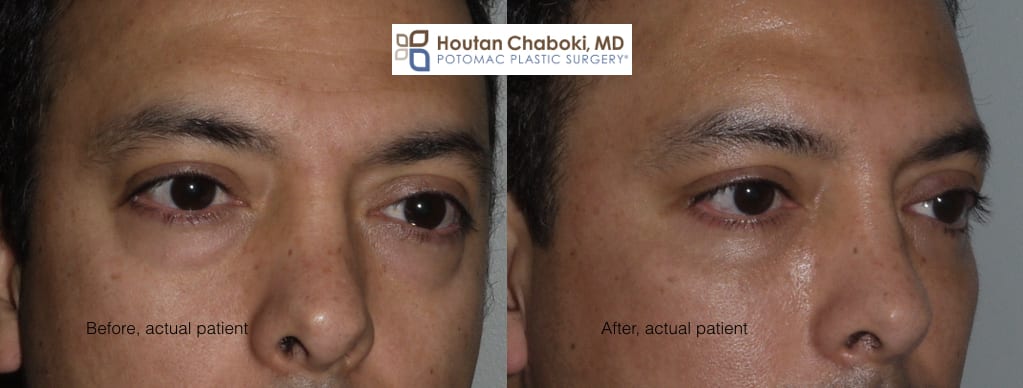
Nonsurgical facial filler (ex. Restylane) injections to improve appearance of eye bags and dark circles.
Dark circles, bags, wrinkles, and flat cheeks may negatively draw one’s attention to this facial area. As a result, we frequently see patients who request cosmetic improvement of their darks under eye circles and lower eye bags. Patients range in age, as cosmetic eyelid treatments are not just for “older” patients. People in their 20’s can have dark circles and eye bags due to genetics. Fortunately, lower eyelid bags and dark circles have many cosmetic treatment options, both surgical and nonsurgical.
What causes dark circles and eye bags?
Lower eyelid bags and dark circles develop from a variety of factors. These factors may come with age, but may also be present from a younger age. Read more on puffy eyes. From an anatomic perspective, dark under circles and eye bags may be from the following:
- Excess fat around the eye itself, protruding forward and creating bulges
- Too little fat in the area beneath or under the eye bag itself, creating a hollow or sunken area and creates a shadow
- Insufficient bone volume of the cheeks
- Loose and wrinkled skin
- Excess pigment or blood vessels in the skin and tissue
Your plastic surgeon can help determine the specific contributing factors to your dark circles and bags. Treatment can then be tailored to your specific factors. Keep in mind that some cosmetic qualities of the lower eyelid, such as prominent blood vessels, are typically not treated.
Treatment options for dark circles and eye bags
First, nonsurgical treatments are typically started, which include basic skin care, tretinoin, and/or chemical peels. Topical creams or ointments that contain hydroquinone or similar lighteners can help improve dark circles for a more uniform skin tone. Light chemical peels or exfoliants may also smooth the skin color and surface. Deeper skin peels require a trip to the dermatology or plastic surgery office.
Skin treatments can help improve the skin quality, pigmentary changes, and overall appearance of the face. Many plastic surgeons and dermatologist will start cosmetic patients on a skin regimen, regardless of having more advanced procedures.
The next nonsurgical option is to add volume to the “valley” of the lower eyelid, commonly referred to the tear trough and infraorbital rim by cosmetic surgeons. Facial fillers (ex. Restylane®) or fat injections are used to plump up this area and help camouflage the eye bag.
Facial fillers are made of a hyaluronic acid gel, which is slowly removed by the body over time. Results may last approximately a year. Eye bag treatment with fillers is performed in the office vial local anesthesia, while fat injections are more commonly performed via IV sedation.
Lower eyelid plastic surgery (blepharoplasty) is required for those appropriate candidates who wants a permanent change for dark circles and eye bags. Cosmetic surgery of the lower eyelid may remove or reposition excess fat, remove sagging skin, and/or tighten eyelid muscle as necessary.

Lower eyelid surgery (blepharoplasty) and fat transfer to improve appearance of eye bags and dark circles.
Facial plastic surgeons typically don’t recommend cosmetic lower eyelid surgery in young patients as the first option. However, each patient is unique and circumstances may vary. Age alone is not a determining factor if a person is a surgical or nonsurgical candidate.
Read more on our website on cosmetic treatment options. What questions do you have regarding lower eyelid bag or dark circle treatments?

I have been using an eye serum. My under eye areas looks a bit brighter and lighter than before, it is really effective. It reduce the fine fine lines, puffiness, and dark circles. By it regular use you will see that it really working very well. Happy with the product. This product is highly recommended
Thank you for your comment!
Treating dark circles may require multiple modalities to help improve appearance. We usually recommend eye creams or topical treatment in addition to filler injections and eyelid surgery.
Best,
Dr. Chaboki